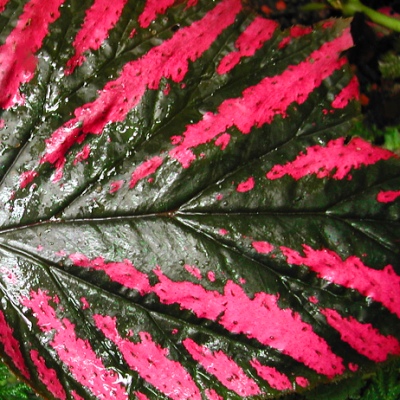Begonia brevirimosa subsp. Exotica
Germinating the seeds
If you have germinated other tropical Begonias before, you may use the same technique that worked for you. The tips below reflect what has worked for me, although other methods can certainly work. Getting started -- Plant your seeds when you receive them for best results. Use about 6 to 10 small pots or cups that are 2-4 inches (5-10 cm) tall. The pots should have drainage holes. A typical soil mix for germinating them is 3 parts potting soil to 2 parts perlite or coarse sand. An alternate mix is equal parts of coir fiber (or peat moss) and perlite, with some slow-release fertilizer added. Fill the containers with the mix and water it until it is evenly moist, but not soggy. The seeds are very tiny, so work in a well-lit area. Sprinkle several seeds evenly across the surface of each pot. An easy way to pick up the seeds is by breathing on your finger tip to lightly moisten it, then dabbing the seeds with it. After sprinkling them on the soil surface, drip a few drops of water over the seeds, to spread them down into the cracks of the soil, which will keep them moist, but still give them light. Do not bury the seeds with soil like you would with larger seeds. Until the seeds sprout, ensure that the soil surface never dries out. You can maintain high humidity by enclosing the pots in a plastic container or bag - just leave it open a crack to let in fresh air. Once or twice a day, drip a few drops of water on the surface to keep it moist. Try to keep the pots between about 65-78 degrees F (18-26°C), both day and night. I don't have experience germinating them outside this temperature range. I recommend placing a minimum/maximum thermometer near the pots. The seeds need light to germinate, so place the containers in a bright spot out of direct sun. A fluorescent bulb kept 4 inches (10 cm) above them provides the right amount of light. The seeds should start sprouting in 2-3 weeks, but may take longer at cooler temperatures. Continue keeping the soil surface moist the first month after they sprout, since young seedlings have a small root system. When they are a month old, you may carefully pull them and transplant them. Or you may simply cut off any slower ones and leave 1 strong seedling in each pot. Fertilizing -- Once your seedlings are 2-3 weeks old, give a very light dose of liquid fertilizer (about 1/8 strength) about every 10 days. When they are 2 months old, you may switch to a slow-release fertilizer, and feed every 2-3 months. On older plants, it's normal for an older leaf to occasionally turn yellow and drop, but if it seems excessive, the plant may need more nitrogen fertilizer. The soil could also be too dry down in the root zone. Watering -- Once the seedlings are a month old, you may stop keeping the soil surface moist at all times. Aim to keep the rest of the soil evenly moist (but not soggy). Lighting -- The plant likes filtered sun or bright shade + morning sun. Protect it from strong afternoon sun. Transplanting -- When the seedlings are 2 months old, repot to a larger container about 1 quart (1 liter) in size. Water the soil before repotting, to keep the soil ball from breaking apart, which can damage the roots. Protect from direct sun the first week after repotting. Climate -- The Exotica Begonia enjoys warmth, but not excessive heat. Temperatures between 60 and 85 degrees F (16-29 C) have worked well. I have no information on how it will do outside that temperature range. It probably can't survive frost. It is said to need high humidity, however it has grown well for me at 45-50% humidity. But i do not recommend lower humidity than that. If it shows signs of stress from low humidity, consider using an ultrasonic humidifier. Pests -- Watch for any pests that may affect your other plants. If you have any questions or problems, please contact me. Enjoy your plants! - Jeff Strange Wonderful Things
|
|||||||||


